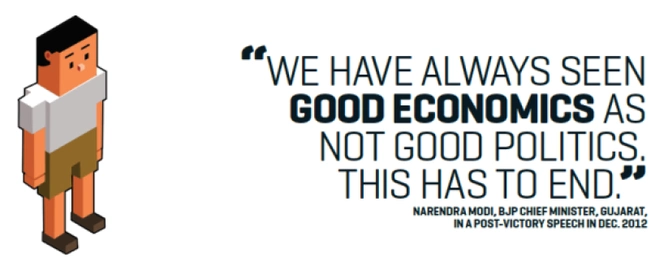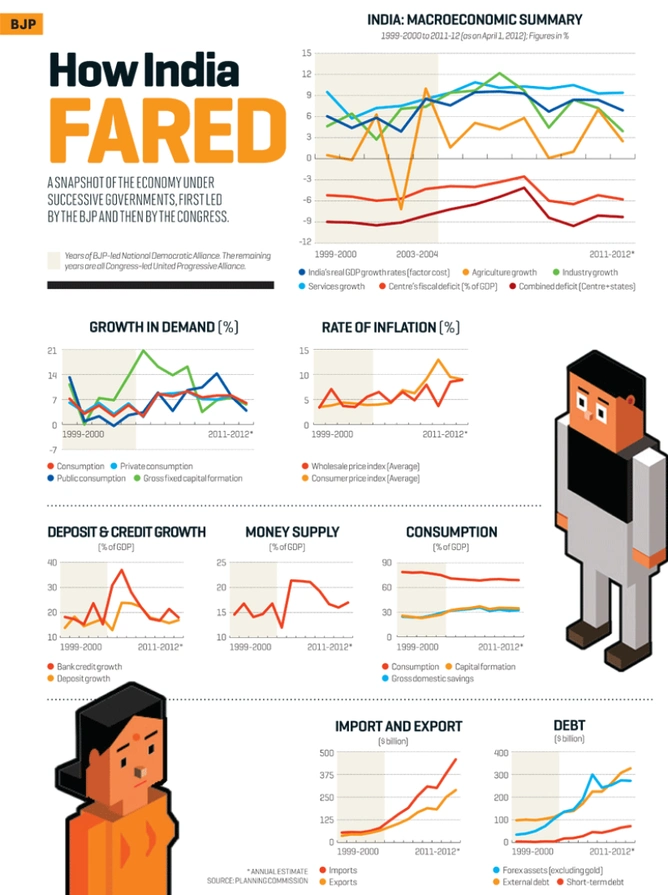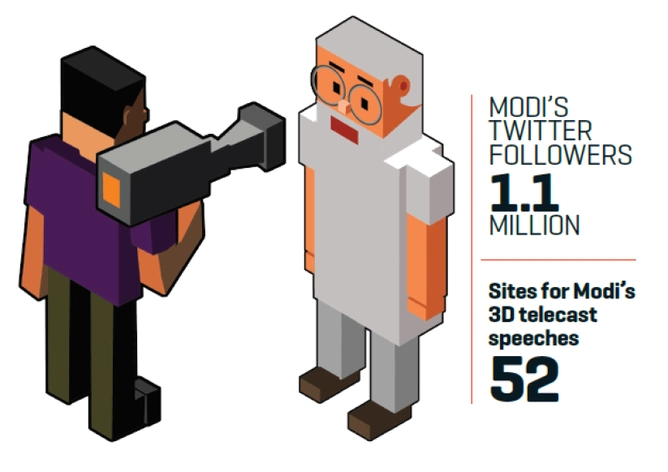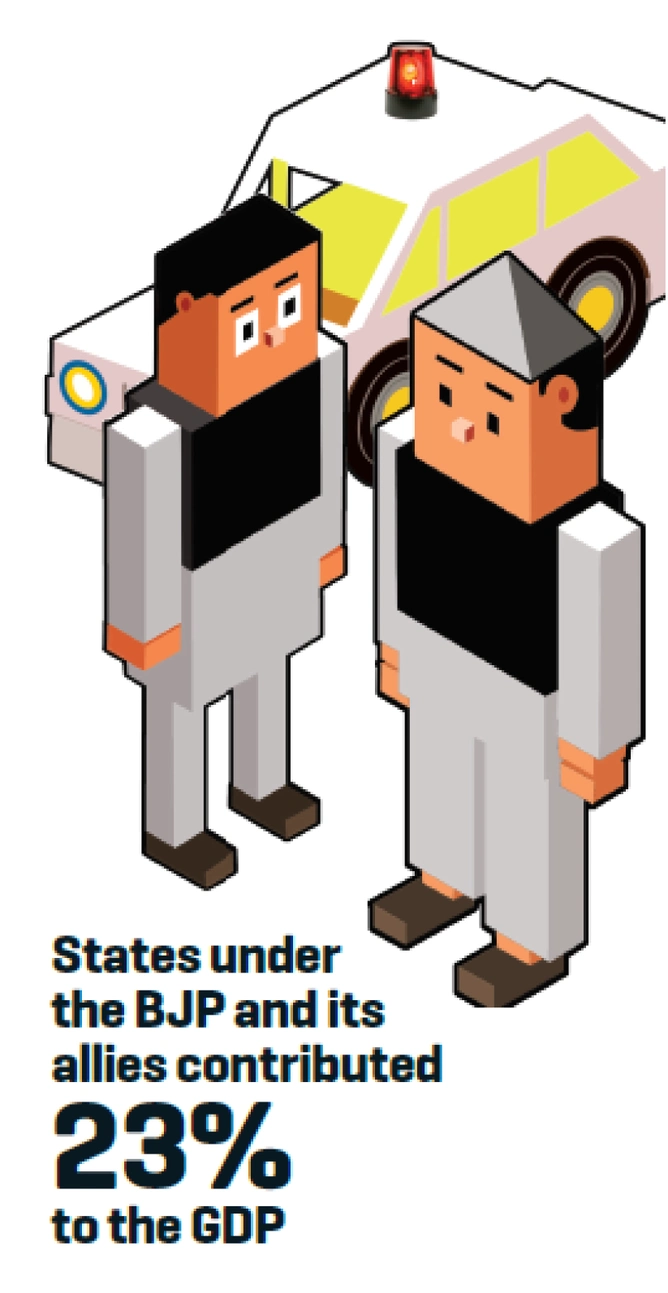It was on Sept. 27, 2012, that a man who had presented four Indian budgets as a steadfast defender of economic reform stood at a lectern at Stanford University and told around 500 students and teachers how his commitment to market-friendly policymaking had only brought him grief. The man was Yashwant Sinha, who took the blame for the Bharatiya Janata Party’s (BJP) rout in 2004. “Sometimes, I feel that I may have been responsible single-handedly for the defeat of my party in the 2004 elections. I can never forget the lessons I learnt in that election,” said Sinha, a member of Parliament, and the man who may be finance minister if the BJP wins the 2014 general elections.
“During my tenure as finance minister I had raised the prices of kerosene oil from Rs 2.50 a litre to Rs 9.50; kerosene oil is used on a large scale in rural areas for lighting as well as cooking. When I went campaigning in a remote village in my constituency, and asked an old woman for her vote, she said that was fine, but was I not responsible for raising oil prices which had made her life difficult?”
Sinha added that even what’s seen as the BJP’s best contribution to development—building new highways—didn’t help it win. The BJP and its allies lost all 14 seats it had won in 1998 along the arterial National Highway 2 connecting eastern and north western India.
A few years before Sinha’s mea culpa, Gujarat chief minister Narendra Modi was preparing for the 2007 elections. With the cloud of one of the most horrific Hindu-Muslim riots hanging over his head, he’d been dubbed maut ka saudagar (merchant of death). His political career would perhaps have been over had he lost. A strong election manifesto was crucial, and senior journalist and BJP ideas man Swapan Dasgupta was asked to help. Modi’s government had come down hard on power theft, which had virtually brought the Gujarat State Electricity Board to its knees. With pilfering reduced, the board was recovering slowly. “There were about two lakh farmers against whom cases had been registered for stealing power. We wrote in the manifesto that if returned to power, the government would waive many of the dues,” says Dasgupta. Politicians traditionally pamper farmers: They are a huge vote bank and win elections. But when the manifesto went to Modi, he said he would not allow the waivers, even though the Congress Party had made farmers having to pay for power a big election issue.
“Modi said not a single case will be withdrawn. He said we are just about turning the electricity board and this will push it back into sickness. He still won [the election],” says Dasgupta.

These two responses to subsidies—Sinha believes that reforms lost the elections; Modi proves otherwise—lays bare an issue that’s intriguing everyone. What does India’s main opposition party, seen for years as the champion of free markets and small government, really think about the economy? The issue has taken sharper overtones over the last year. The ruling Congress has been in retreat, defeated by legions of scams, spiteful allies, and a Prime Minister widely seen as timid. Yet, the BJP has been unable to exploit these near-perfect conditions to script its return. If the Congress has been in disarray, the BJP’s plight is no better.
Part of the BJP’s problems is the fact that its senior leaders demonstrate as much camaraderie as lions fighting over a carcass. The party has been unable to present a unanimous alternative, especially in the area of economic reform. With the national elections due next year, it’s a question that’s vexing India Inc. particularly.
In recent months, as the Congress-led government has appeared ineffective in reviving the economy, heads of large companies have often privately wondered why the BJP is finding it difficult to even debate an alternative. To them, the BJP’s indecisiveness is baffling because during its tenure between 1998 and 2004, the economic direction never seemed in doubt. The alliance it led was the first to create the Disinvestment Ministry headed by Arun Shourie to sell off state-owned companies, for example.
But today, consider the party’s flip-flop over foreign direct investment (FDI) in multi-brand retail. In its economic manifesto for the 2004 national elections, the BJP indicated that it would allow limited FDI in multi-brand retail. This demonstrated a degree of boldness, because the party has traditionally been backed by small shopkeepers, who are popularly painted as the segment that will lose the most, in all FDI debates. But despite having once proposed the idea, it fiercely opposed the Congress’s move to allow foreign investment in retail and even teamed up with the Left to prevent it from happening.
Even if some of this is sheer opportunism and partisan politics, it’s not as if the BJP shouted down multi-brand retail FDI unanimously. In Punjab, where the ruling BJP and the Akali Dal combine won last year, deputy chief minister Sukhbir Badal, son of chief minister and Akali leader Parkash Singh Badal, first supported FDI, and then under pressure from the BJP, backed off. Again, as Dasgupta points out, Modi may have made the right noises after being prodded by the party, but he is certainly not fundamentally averse to the idea. And then there was Shourie, a Rajya Sabha member, who said the party shouldn’t oppose matters they’d have to back if they were in power.
Shyama prasad mookerjee, founder of the Bharatiya Jan Sangh, the BJP’s precursor, was a free market proponent. He was the industry minister in Jawaharlal Nehru’s cabinet, and ended up disagreeing with Nehruvian socialism. Economic freedom, he argued, is one of the four key planks of nation building, along with national, political, and personal liberty. “Freedom is not only in the absence of restraint but also in the presence of opportunity,” he famously said on Nov. 27, 1937 at the Patna University convocation ceremony. After falling out with Nehru, Mookerjee started the Jan Sangh in 1951. The twist is that the Jan Sangh and Mookerjee were closely associated with their ideological parent, the nationalist Rashtriya Swayamsewak Sangh (RSS), a strong advocate of swadeshi or homemade growth in every field—from culture and clothing to companies. Deen Dayal Upadhyaya, another Jan Sangh stalwart, adapted swadeshi to create the idea of antyodaya or caring for the poorest of the poor.
The philosophies of Mookerjee and Upadhyaya give the BJP the political manoeuvrability to pick and choose what it wants to tap into. One of Mookerjee’s famous disciples, former Prime Minister Atal Bihari Vajpayee, used to narrate a story from the mid-1950s when he was a young MP in a Parliament led by Nehru. Parliament was debating building The Ashoka Hotel, India’s first luxury hotel to be constructed by the state. In one of the debates, Vajpayee said the job of the government is to build hospitals, not hotels. Nehru was furious at the intrusion of a junior MP from a virtually non-existent party. He told Vajpayee that he didn’t understand anything and added that the state would build hospitals from the hotel’s profits. Decades later, Vajpayee would joke that the hotel was still making losses (Shourie’s ministry nearly sold it) and the state had failed to build enough hospitals.
Nitin Gadkari, the current BJP president, brought antyodaya centre stage after he took charge in 2009 following the second successive defeat of the party in the polls. In 2004, the Congress campaign slogan was Congress ka haath aam admi ke saath (the hand of the Congress is with the common man), which trumped the BJP’s India Shining campaign. In 2009, the Mahatma Gandhi National Rural Employment Guarantee Act (NREGA), which promised at least 100 days of employment for the rural poor, helped the Congress win again.
Today, as the BJP once again limbers up for the polls, there’s a feeling within that economics can be one of the main agendas to battle the Congress. A combination of low growth, high interest rates, fewer employment opportunities, food inflation—essentially issues that affect everyone—has made that possible.
There’s also the emergence of a New Dreaming Class, which cuts across every electoral boundary of caste, religion, region, or even income. On the one hand, this class dreams of a corruption-free India (and believes in what Anna Hazare and Arvind Kejriwal stand for), on the other it scrimps and saves to send its children to private schools, eschewing the dysfunctional state option. There are at least 150 million people in this class, who (according to multiple government agencies) earn between Rs 3.4 lakh and Rs 17 lakh a year, and are growing at 13% a year. Many of them voted for Manmohan Singh. If the BJP can tap into their imagination and organise even a fraction of them, the election may be theirs. As Dasgupta says, 2014 will be the election of dreamers and those who can make people dream more.

TO UNDERSTAND WHERE THE BJP’s economic thinking is taking place, draw two parallel lines through the heart of India. The states that fall within these are, west to east, Gujarat, Madhya Pradesh, Chhattisgarh, Jharkhand, and Odisha. In recent years, all of them have been clocking growth of over 10%, and all are BJP-ruled, except Odisha, where the BJP has a strong presence and had a successful coalition government with the ruling Biju Janata Dal (BJD) till 2007.
Last year, Gujarat grew by 12.2%, Madhya Pradesh 10.7%, Chhattisgarh 18.1%, Jharkhand 10.8%, and Odisha 14.8%. Bihar, where the BJP has a strong coalition with the ruling Janata Dal (United) (deputy chief minister Sushil Kumar Modi is from the BJP) grew by 21.6% last year; Karnataka, where incessant infighting has repeatedly paralysed the state government, clocked a growth of 15.7% and so on. The BJP also rules in Goa and Punjab. But the core of the party’s economic thinking lies in the heartland states, which account for more than 100 million people (Madhya Pradesh accounts for the bulk), and contributes to around 23% of GDP.
Shourie says the BJP-ruled states and its chief ministers are the party’s showcase, and these states and leaders have emerged as the Petri dish of experimentation in governance. “And this is percolating all the way up to the BJP headquarters at 11, Ashoka Road, in Delhi,” he says. In other words, these states are beginning to influence the BJP’s economic thinking.
This is the key difference between the Congress and the BJP today. In the Congress, power still trickles down from party president Sonia Gandhi and son Rahul. In the coming elections, the economic outlook of the Congress will be shaped by leaders such as P. Chidambaram, Jairam Ramesh, Kamal Nath, Salman Khurshid, and Kapil Sibal, each primarily a part of the Delhi-based central leadership.
In the BJP, leaders such as Gujarat chief minister Modi (on his third term after a recent re-election), Madhya Pradesh chief minister Shivraj Singh Chouhan, or Chhattisgarh chief minister Raman Singh will influence the party’s thinking at the Centre. If both Chouhan and Singh swing a third term in power, they will have an even greater say.
So, whether it’s the new capital being built by Singh in Naya Raipur, an example of urban renewal at a time when cities across India are collapsing and barely any new ones are being built, or the measures taken by Chouhan to reduce agricultural interest rates to 1% which was later copied by other states, or Modi providing electricity to almost every household and creating a single-window clearance for business, these are invaluable inputs to the promise list the BJP wants to make for the next polls.
“States are becoming very important in the process of economic development,” says Sinha. “A large part of our thinking is soaked up from the states. We have to agree that wisdom is not the prerogative of Delhi.” He adds that many of India’s urgent needs, from banking reform and financial inclusion to appropriate compensation for land acquisition, are better driven by states than the Centre.
REGARDLESS OF IDEOLOGY, deferring to states is new in Indian politics. But, as party insiders tell us, the BJP’s central leadership has realised that if it loses the 2014 elections, the party would have been out of power for three successive terms, or 15 years. That’s a long time in politics and no mainstream party in India has ever been out in the wilderness for so long. As a senior party man points out, “If the party wants to win, it had better listen to the state leaders.” Or, as Jaswant Singh, a senior BJP leader who served as finance minister and external affairs minister, says, “We want a federal India where the states have more and more power. If we truly want that, how can we expect that they will always listen to us? They win elections there.
Their knowledge is bottom-up.” Shourie adds: “I don’t speak for the party but our slogan is, or ought to be—we’ve delivered [in the states].”
A senior BJP leader and former cabinet minister talks of the relationship between Delhi and the BJP’s regional satraps. Earlier this year, Modi spoke to former BJP president Rajnath Singh asking for help with negative media reports from Delhi about him. “Singh was in seventh heaven,” says the leader. “He couldn’t believe that Modi had reached out to him.” Singh has an aide who is also an astrologer whom he consults frequently. Some weeks after this event, the astrologer met a key Modi aide. Every Prime Minister needs a second-in-command, said the astrologer, and if Modi becomes Prime Minister, who better than a rural leader [Rajnath Singh] from the biggest state, Uttar Pradesh? The Modi aide replied, “Narendrabhai is numbers 1 to 10, so there is no question of a No. 2. After 10, we can see what we can do for you.”
This is not to say that there will be no inputs from central leaders. Sinha says that given another chance, there are four things that’ll top his agenda—bring down the number of central government-funded schemes from 147 to 10, have them fully financed by the Centre, do away with joint financing with the states, and have stringent monitoring of the schemes. “At the moment, some 100 schemes have a budget of less than Rs 300 crore. What we would apply are 10 big-ticket schemes in infrastructure, power, health, and agriculture, which will be on the basis of demand from the states—a bottom-up approach, instead of top down,” he says.
Both Sinha and Shourie also worry about the ballooning fiscal deficit, which is estimated to be around 5.5% of the gross domestic product (GDP) for FY13. Sinha’s formula to reduce the deficit to less than 3% hinges on what he calls “immediately implementable planning”. He suggests dismantling the current system of five-year plans, and reducing the span to two years to be able to focus on what can be implemented quickly. The idea of a Planning Commission with five-year terms was borrowed from the Soviets and dates to Nehru’s first prime ministerial term.

Shourie says he despairs at the use of monetary policy to curb inflation, which, he says, is like “using an axe to kill a mosquito”. “We are in this vicious cycle. Neglect inflation, fiscal deficit spins out of control, and we respond through increased interest rates. We have off-budget expenses each year of around Rs 2 lakh crore [in fuel and fertiliser subsidies] and no one talks about that,” he says, proposing a complete freeze on all hikes in government expenditure except in defence and internal security. “We must restrict the use of monetary policy and focus on fiscal policy. The focus must be on efficient delivery.” If in power, the BJP will, of course, have to convince its allies about these ideas.
Both Sinha and Shourie also argue against the Gadgill-Mukherjee formula of distribution of central funds to states. Created in 1990 by social scientist D.R. Gadgill and Pranab Mukherjee, who was then deputy chairman of the Planning Commission, the formula says that of every Rs 100 sent to the states, 60% is on the basis of population (so a larger population means more assistance), 25% on the basis of per capita income, 7.5% on fiscal management, and 7.5% on special problems, including disasters and crumbling urban spaces. Shourie and Sinha argue that after liberalisation, with states often taking their economic destiny in their hands, the formula is irrelevant.
Six years ago, Modi had begun railing against the Gadgill-Mukherjee formula. He called it a formula that punished fiscally responsible, innovative, and aggressively growing states. He suggested instead that each state be allowed to choose three critical areas for assistance, instead of the Centre judging needs and allocating budgets. With a Congress government at the Centre, Modi’s suggestions were predictably dismissed, but if the BJP wins, expect the Gadgill-Mukherjee formula to be re-crafted, if not scrapped outright. This will enable states to wield greater control over their fiscal planning.
Even on curbing fiscal deficit, the BJP knows its states can show the way. According to a report by the PHD Chamber of Commerce in July, most of the heartland BJP states had reined in their deficit at less than 3%. The report listed Chhattisgarh as ‘excellent’ with a deficit of 1.9% of the state GDP, while Madhya Pradesh and Gujarat were ‘very good’ at 3%, as was Bihar at 2.9% and Odisha at 1.8%; Jharkhand was ‘good’ for bringing down deficit from 7.4% to 3.7%.
Mukul Asher, professorial fellow of public policy at the National University of Singapore, who tracks the economies of Indian states, says Gujarat, with massive investments in infrastructure, whether roads or electricity distribution, has the right ideas about balancing public investment and debt. “With debt, one has to see where the money is going and if there are going to be returns,” says Asher. “If the money is all going into empty subsidies, there is a problem.” Shourie agrees that the focus on delivery as a method to curb fiscal deficit comes from “the relevance of Modi and the Gujarat model”.
Economist Bibek Debroy is the author of Gujarat: Governance for Growth and Development. He says the much-discussed aspects of the economy under Modi, such as state GDP growth, are less interesting than some more vital but often-ignored issues such as decentralised planning, empowering the bureaucracy, and using the private sector to deliver social schemes.
Debroy points to the Chiranjeevi Yojana (a health-care reimbursement plan) under which the state reimburses private clinics and doctors for neonatal care, and transport costs to a health-care centre for below poverty line (BPL) mothers. Using a BPL card to identify patients, the scheme pays gynaecologists Rs 1,795 for every birth, Rs 200 for the mother to travel to the clinic and Rs 50 to the person accompanying the mother. According to the Gujarat government, the infant mortality rate has fallen from 60 deaths per 1,000 births to 44 last year and the scheme has won the Singapore Economic Development Board’s Asian Innovation Award.

In education, Modi’s Gunotsav primary school grading scheme has improved attendance and quality, says Debroy. “Modi’s model breaks the idea of targeting the poor based on caste and religion. There’s no doubt that his model is innovative but for it to work across India, it would have to work in states such as Uttar Pradesh and Bihar. Are these states ready to break out of the caste- and religion-based state support model? I am not sure and that will be his challenge,” he says.
Prakash Javadekar, Rajya Sabha MP and member of the economic cell of the BJP, says: “The fundamental difference between us and the Congress is that we do not want the whole country on dole. So our focus, if we return, will clearly be on asset creation.” He is referring to schemes such as NREGA, the Congress’s recent announcement that it will build houses for the poor, and various subsidies.
He says the party will push for the implementation of the recommendations of the committee on agriculture headed by Dr M.S. Swaminathan, pioneer of the Green Revolution, which suggested fixing government procurement of any agricultural commodity at production cost plus 50%.
THE BJP’S IDEOLOGY can be called free-market nationalism—it believes in a free market, but only if it helps in nation building. Free-market nationalism is even reshaping how the RSS thinks. Take the issue of swadeshi. RSS spokesperson Ram Madhav explains: “Earlier it was easy to say this is Indian and this is not. But now a company might have a foreign name, but the majority shareholder might be Indian; the reverse could also be true. So the way we look at swadeshi has also moved with the times. The focus is no longer on names or products but on what’s benefiting India. If it benefits India, we welcome it.”
Chouhan agrees: “In a place where there are many poor people, their needs must be taken care of by the government in a targeted fashion. To say that the market will eventually fix the problems is not correct. We cannot wash off our responsibilities.”

Suresh Prabhu, a member of the Shiv Sena, a BJP ally, who was environment minister during the Vajpayee government, says that if returned to power, the BJP and its allies will “translate policy thinking to policy making”. He adds that his priority areas are water, electricity, infrastructure, and education. “Look at all the stupidity about not privatising education: Well, guess what, education is privatised! The poor man is scraping and saving and sending his kids to a private school so they get a good education and learn English. Why do we have such hypocrisies? Because there are vested interests,” he says, calling for implementation of strict regulations on setting up schools and colleges, and letting private players come in.
JAYANT SINHA IS in a unique position to observe all this. One of the two sons of Yashwant Sinha, he is the India head of social business fund Omidyar Network. He’s also part of the BJP’s right-leaning policy think tank, the India Foundation.
“Let’s forget Right or Left. Think of it like this—there’s a crying child, known as the issues of India. It needs to be pacified. One way is to mollycoddle it and give it a little food but keep cuddling it. The other way is to give it food but no cuddling. Tough love. Is India ready for tough love? That is the question.”
Traditionally, political parties associated good, responsible economics with bad politics (the food plus cuddle). In his first public speech after the election results came in, Modi said his win demonstrated that the causality of good economics making for bad politics was broken. Now, it’s for the rest of the party to take his cue. And those of his fellow chief ministers.










Leave a Comment
Your email address will not be published. Required field are marked*